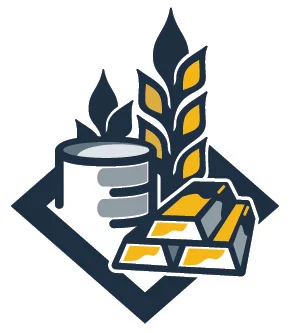Commodity in focus
The last few months has seen a remarkable shift in market sentiment. While previously it seemed like everyone was talking about the same market view regarding direction, and this was backed up by the prevailing up-trend, this has changed significantly since the new year.
We are not talking about equity markets. We are talking about commodities.
A year ago no one wanted to talk about Commodities - what a difference a year makes. At Auspice we believe the opportunity in commodities is greater than we have seen in almost 10 years. The fact is that, like anything, there are periods of opportunity and periods of challenge. We believe this is a rare opportunity. So when does one step in?
As we have said many times before, timing things is hard (see February 5th blog post). As such instead of focusing on perfect timing (an arguably futile effort), we advocate for aiming to build better portfolios. At Auspice we believe adding commodities builds a better portfolio, and the data backs this up. As outlined in the Auspice published white paper (Benefit 2: Diversification on page 5):
Despite the lackluster performance of commodities over the last decade, including the (commodity) asset class in a portfolio long-term is historically accretive. Moreover, “Including a tactical broad commodity index allocation has the ability to improve overall performance and significantly reduces volatility and drawdowns.” Per the Figure below, the addition of this commodity benchmark not only improves historical returns and risk metrics, it also reduces the portfolio correlation to the (stock) market itself.
So while timing isn’t everything, and who knows if its “perfect”, it looks decent right now. And from a portfolio perspective, we know it makes sense.
Unfortunately, there is very little product in this space in Canada. However, Auspice has been managing tactical broad commodity exposure in this space for many years. Please reach out and let’s try to find a solution for you or your organization.
For more information on this topic, please refer to the Auspice Commodity white paper on the website under Resources/Research.
For more information, give us a call.
Disclaimer
IMPORTANT DISCLAIMERS AND NOTES
Futures trading is speculative and is not suitable for all customers. Past results is not necessarily indicative of future results. This document is for information purposes only and should not be construed as an offer, recommendation or solicitation to conclude a transaction and should not be treated as giving investment advice. Auspice Capital Advisors Ltd. makes no representation or warranty relating to any information herein, which is derived from independent sources. No securities regulatory authority has expressed an opinion about the securities offered herein and it is an offence to claim otherwise.
COMPARABLE INDICES
Auspice Broad Commodity Excess Return Index (ABCERI): The Auspice Broad Commodity Index aims to capture upward trends in the commodity markets while minimizing risk during downtrends. The index is tactical long strategy that focuses on Momentum and Term Structure to track either long or flat positions in a diversified portfolio of commodity futures which cover the energy, metal, and agricultural sectors. The index incorporates dynamic risk management and contract rolling methods. The index is available in total return (collateralized) and excess return (non-collateralized) versions.
*Returns for Auspice Broad Commodity Excess Return Index or “ABCERI” represent returns calculated and published by the NYSE. The index does not have commissions, management/incentive fees or operating expenses.
The performance of Auspice Broad Commodity Index prior to 9/30/2010 is simulated and hypothetical as published by the NYSE. All performance data for all indices assumes the reinvestment of all distributions. To the extent information for the index for the period prior to its initial calculation date is made available, any such information will be simulated (i.e., calculations of how the index might have performed during that time period if the index had existed). Any comparisons, assertions and conclusions regarding the performance of the index during the time period prior to the initial calculation date will be based on back-testing.
The S&P 500 is an index of 500 stocks chosen for market size, liquidity and industry grouping, among other factors. The S&P 500 is designed to be a leading indicator of U.S. equities and is meant to reflect the risk/return characteristics of the large cap universe. Price Return data is used (not including dividends).
60-40 Portfolio: 60% investment in SPY (S&P 500), 40% investment in BARCAP US AGG Bond index, rebalanced annually.
BARCAP US AGG Bond: the Bloomberg Barclays US Aggregate Bond Index is a market capitalization-weighted index, meaning the securities in the index are weighted according to the market size of each bond type. Most U.S. traded investment grade bonds are represented. Municipal bonds, and Treasury Inflation-Protected Securities are excluded, due to tax treatment issues. The index includes Treasury securities, Government agency bonds, Mortgage-backed bonds, Corporate bonds, and a small amount of foreign bonds traded in U.S. The Bloomberg Barclays US Aggregate Bond Index is an intermediate term index. The average maturity as of December 31, 2009 was 4.57 years. The Bloomberg Barclays US Aggregate Bond Index, which until August 24, 2016 was called the Barclays Capital Aggregate Bond Index, and which until November 3, 2008 was called the "Lehman Aggregate Bond Index," is a broad base index, maintained by Bloomberg L.P. since August 24, 2016.
QUALIFIED INVESTORS
For U.S. investors, any reference to the Auspice Diversified Strategy or Program, “ADP”, is only available to Qualified Eligible Persons “QEP’s” as defined by CFTC Regulation 4.7.
For Canadian investors, any reference to the Auspice Diversified Strategy or Program, “ADP”, is only available to “Accredited Investors” as defined by CSA NI 45-106.


